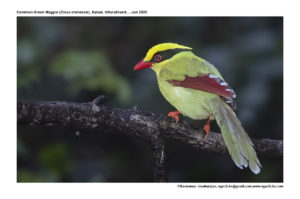
Common Green Magpie Cissa chinensis
Etymology:
- Cissa : Greek word for Magpie
- Chinensis : From China
Vernacular Names : Ben: Sirgoom, Sirgang, Ass: Lil sorai, Cachar: Dao gatang lili, Dafla: Telpili, Lepcha: Chap ling pho, Bhutan: Rab ling chapa, Sikkim: Dhori koili, Hindi: Hara Mahalat
Distribution in India: Resident of Himalayas from Uttarakhand (Garhwal) Eastwards to North East India (Arunachal Pradesh, South Assam hills)
Description: Size of 37–39 cm; wt. of 120–133 g. It is a distinctive and striking green magpie with graduated long tail, slightly shaggy rear crown, prominent bill, nostrils concealed by soft plumes green, yellow and red colours of plumage bleach to, respectively, dull light blue, whitish and brown if exposed to prolonged bright sunlight. The nominate race has prominent black band from base of bill across side of head, enclosing eye and crossing under slight crest on nape. Rest of head, entire body plumage, scapulars, lesser upperwing-coverts and upperside of tail are grass-green to pea-green. Remainder of wing is reddish-chestnut, tertials are prominently tipped black and white, forming “ladder” on closed wing. All the tail feathers except pale-tipped central pair have black subterminal chevron and whitish tip, underside of tail appears pale with blackish band across base. With wear and time, plumage bleaches to light blue, with pale brown wings. The iris is dark brown, crimson orbital ring which in excitement can be inflated into small horn-like wattle. The bill is crimson to orange-red, often whitish at very tip; legs are bright red to orange-red. Both the sexes are similar. The juvenile is duller overall, becoming almost whitish on undertail-coverts, has bill and legs as yellowish-horn, iris is dull grey-brown, tail feathers are relatively shorter and more pointed at tips than on adult, and tertial pattern is duller with weaker dark marks.
Habitat: It is found in tropical and subtropical broadleaf evergreen and mixed deciduous forests, chiefly in foothills, forest borders, edges of tea and cardamom plantations and secondary forest, with shrubbery, ravines and bamboo thickets, especially along watercourses. It is found at 600–2100 m.
Food Habits: It eats beetles, crickets, mantises, small frogs, snakes, lizards and bird’s eggs and nestlings, raids nests of Glossy Swiftlets and nest of hornet. It feeds on carrion, and fruits and berries. It is found singly or in pairs or often associating with laughingthrushes and Drongos. These noisy mixed foraging parties move from one thicket to another. It readily forages on ground, noisily turning over leaf litter, working its way up through shrub layer, clambering between hanging creepers, sometimes ascending to upper canopy.
Breeding habits: They breed in Apr and May in India. They are solitary breeders. The nest is a bowl of twigs, interwoven with leaves and rootlets, the relatively deep cup lined with soft plant materials, including mosses, usually well concealed in small tree, amid shrubbery or in bamboo. They lay a clutch of 3–7 eggs.